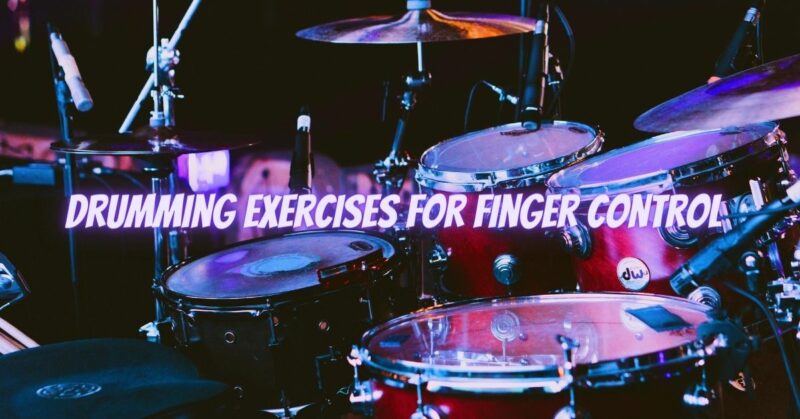Developing finger control is crucial for drummers seeking to enhance their speed, precision, and dexterity. Strong finger control allows for intricate and nuanced drumming techniques, such as fast single strokes, rolls, ghost notes, and intricate fills. In this article, we will explore essential drumming exercises specifically designed to improve finger control and strengthen the muscles in your fingers.
- Single Stroke Rolls: Single stroke rolls are the foundation of drumming and require precise finger control. Start by practicing slow, even single strokes using alternating hands. Focus on maintaining consistent stick height, stick rebound, and equal strength in both hands. Gradually increase the speed while maintaining control and accuracy. Practice playing single stroke rolls at various tempos and dynamic levels to develop control and endurance.
- Finger Control Exercises: a. Finger Rolls: Roll the stick between your fingers, starting from the fingertips and moving towards the palm. Practice this exercise with each finger individually and then with multiple fingers. Focus on maintaining a smooth and controlled roll while using minimal wrist and arm movement. b. Finger Control Accents: Accent various notes within a pattern or rudiment using finger strokes. For example, play a paradiddle pattern while accenting the second note of each group using your fingers. This exercise helps develop finger strength, control, and coordination.
- Finger Independence Exercises: a. Finger Drumming: Use your fingers to simulate drumming patterns on a tabletop or practice pad. Assign different fingers to different drums, such as your index finger for the snare, middle finger for the hi-hat, ring finger for the tom, and pinky finger for the cymbals. Practice playing different rhythms and patterns using only your fingers, focusing on maintaining control and accuracy. b. Finger Independence Rudiments: Practice rudiments that focus on finger independence, such as the flam tap or the single paradiddle. These exercises require precise finger control and coordination between your fingers.
- Finger Strengthening Exercises: a. Finger Push-Ups: Place your fingers on a flat surface with your palm facing down and push your fingers down, lifting your palm off the surface. Hold this position for a few seconds before releasing. Repeat this exercise multiple times to strengthen your finger muscles. b. Finger Resistance Bands: Use finger resistance bands specifically designed to strengthen the muscles in your fingers. Place the band around your fingers and open your hand against the resistance, then close your hand back into a fist. Repeat this exercise with varying levels of resistance to build finger strength.
- Hand and Finger Stretches: Before and after playing, perform hand and finger stretches to improve flexibility and prevent injury. Stretch each finger individually by gently pulling it back towards your wrist. Additionally, stretch your hands by spreading your fingers apart as wide as possible and then bringing them together. Repeat these stretches several times to increase flexibility and reduce tension in your hands and fingers.
- Practice with Control and Accuracy: When practicing finger control exercises, focus on maintaining control, accuracy, and consistency. Start at a slow tempo, ensuring that each stroke is clean and precise. As you become more comfortable, gradually increase the speed while maintaining control. Pay attention to the quality and sound of each stroke, aiming for evenness and clarity.
- Use a Metronome: Utilize a metronome when practicing finger control exercises to develop a sense of timing and to improve your ability to play with steady rhythm. Start at a comfortable tempo and gradually increase the speed as you become more proficient. Focus on aligning your finger strokes with the metronome clicks, maintaining a consistent and accurate pulse.
- Apply Finger Control to Musical Context: Once you have developed stronger finger control, apply it to musical context by incorporating the exercises into grooves, fills, and musical passages. Experiment with different musical styles and genres to apply your newfound finger control skills. Practice playing along with songs or backing tracks to enhance your ability to apply finger control techniques in real musical situations.
Conclusion: Improving finger control is a process that requires patience, consistency, and focused practice. By incorporating single stroke rolls, finger control exercises, finger independence exercises, finger strengthening exercises, hand and finger stretches, practicing with control and accuracy, using a metronome, and applying finger control to musical context, you can strengthen your fingers, enhance your speed and precision, and unlock new possibilities for creativity and expression behind the drum kit. Remember to start slowly, maintain good technique, and gradually increase the difficulty as you progress. With dedicated practice and perseverance, you will see significant improvements in your finger control, enabling you to execute complex drumming techniques with finesse and confidence.


